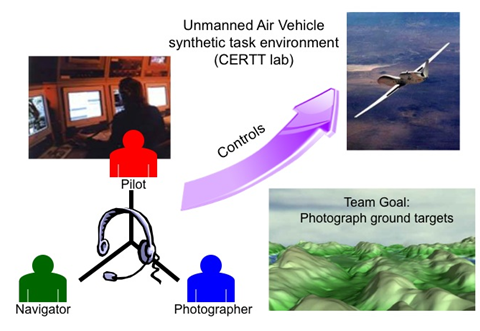|
Team Coordination: Individuals Function as a Cohesive Group

|

Three team members coordinate their actions to control the movements of a
plane that photographs the landscape below. We see different coordination
strategies evolve for different teams. |
|
|
|
In business, educational settings, and military operations, teams can often accomplish more than individuals working alone. Individuals bring unique but complementary sets of skills and knowledge to the team. The challenge is for those individuals to function as an integrated unit that remains stable across normal fluctuations in task demands but can also respond quickly and appropriately to unexpected perturbations. Keeping the group centered on task is a balancing act that is achieved through the flexible interaction of group members.
We use the tools of nonlinear dynamics to identify the behavioral “signatures” of teams during a command-and-control task in which three individuals, each trained to perform a different role, must coordinate operations of an unmanned air vehicle to photograph ground targets. We developed a metric of team coordination that captured the relative timing of coordination events. Analyses revealed more rigid dynamics for teams that retained membership (same teams) compared to teams that were mixed following a lengthy retention interval. That nonintuitive finding led to the development of new training strategies for teams. We are currently developing real-time analyses that will enable us to assess and redirect team coordination as it occurs.
Coordination is a general phenomenon that shows up both within a single individual and across individuals. In the case of team coordination, the team members interact to function as a single, cohesive unit.
This research is conducted in collaboration with members of Cognitive Engineering Research Institute.
|
For more details, please click here


